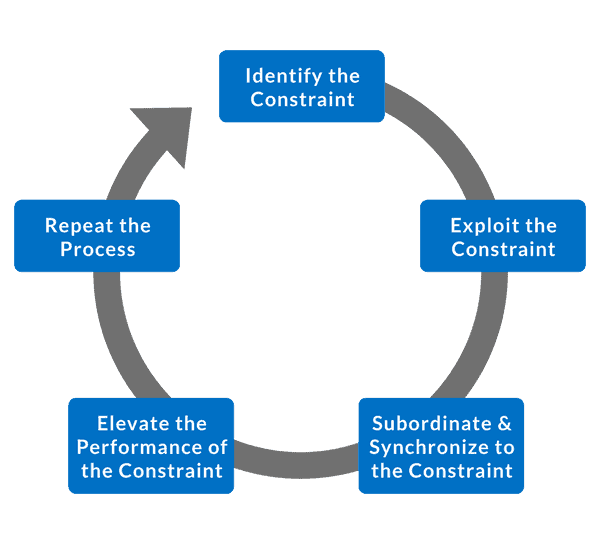What Is Theory Of Constraints? In this blog post, we'll unravel the mysteries behind this transformative theory, its goal, its examples, and the 5 steps of TOC for identifying and resolving organizational challenges. Get ready to elevate your business to new heights as we delve into the fundamentals of the Theory of Constraints.
Table Of Contents
- What Is Theory Of Constraints?
- What Is The Goal Of Theory Of Constraints?
- 5 Steps Of Theory Of Constraints
- Benefits Of Theory Of Constraints
- What Is Theory Of Constraints Example
- Common Challenges In Implementing Theory Of Constraints
- Final Thoughts
- FAQs
What Is Theory Of Constraints?

Theory of Constraints Definition:
The Theory of Constraints (TOC) is a management approach that helps organizations improve their performance by identifying and solving problems that prevent them from achieving their goals. This approach aims to make the organization more effective and efficient.
Theory of Constraints Explained:
The Theory of Constraints is a method to make organizations work better. It says that every system has things holding it back (constraints), like slow processes or not enough resources. The idea, inspired by the Author of Theory of Constraints - Eliyahu M. Goldratt, is for organizations to find these issues, put them in order of importance, and then fix them one by one. This way, organizations can improve how they work and do better overall.
What Is The Goal Of the Theory Of Constraints?
The main aim of the Theory of Constraints (TOC) is to make organizations work better by finding and fixing things that slow them down. It helps overcome obstacles, simplify processes, and improve efficiency overall. The goal is to boost productivity by dealing with the most important issues that affect the whole system. In a nutshell, TOC is a smart strategy for organizations to reach their goals faster and more effectively.
5 Steps Of Theory Of Constraints

The Theory of Constraints (TOC) follows a systematic approach to enhance organizational performance. Here are the key steps involved:
1/ Identify Constraints:
The first step is to pinpoint the constraints or bottlenecks within the system. These constraints could be processes, resources, or policies that limit the organization's ability to achieve its goals.
Identifying these constraints is crucial for the success of the TOC methodology.
2/ Exploit Constraints:
Once identified, the next step is to make the most of the existing constraints. This involves optimizing and leveraging the constrained resources to their fullest potential.
By maximizing the output of the bottleneck, the organization can improve overall efficiency.
3/ Subordinate Everything Else:
Subordination is about aligning non-constraints or supporting processes with the constraints. It means ensuring that all other activities and processes work in harmony with the bottleneck.
The goal of this step is to avoid overloading a limited resource and to maintain a steady flow throughout the system.
4/ Elevate Constraints:
If exploiting the constraints and subordinating other processes are not sufficient, the focus shifts to elevating the constraints. This involves investing in additional resources, technology, or capacity to alleviate the bottleneck and increase overall system throughput.
5/ Repeat the Process:
Continuous improvement is a fundamental aspect of TOC. After addressing one set of constraints, the process is repeated.
Organizations can continuously identify and improve constraints by following an iterative cycle. This ensures ongoing optimization and adaptation to changing circumstances. By doing so, they can consistently improve their processes and ensure they remain efficient and effective.
Benefits Of Theory Of Constraints

Increased Productivity:
The Theory of Constraints (TOC) helps organizations pinpoint and tackle the factors that slow down their operations. By addressing bottlenecks and constraints, organizations can significantly boost their productivity, achieving more with the same resources.
Enhanced Efficiency:
TOC focuses on streamlining processes by identifying and optimizing constraints. This results in more efficient workflows, reducing delays and improving the overall effectiveness of organizational activities.
Optimized Resource:
One of the key benefits of TOC is the strategic allocation of resources. By understanding and addressing constraints, organizations can use their resources more effectively, preventing unnecessary strain and ensuring optimal utilization.
Improved Decision-Making:
TOC provides a structured framework for decision-making by highlighting the most critical constraints. This helps organizations prioritize actions and investments, making informed decisions that have a significant impact on overall performance.
What Is Theory Of Constraints Example
Here are some examples of how the Theory of Constraints can be applied in different industries:
What is theory of constraints in supply chain management
In supply chain management, the Theory of Constraints might be applied to identify and address bottlenecks that impede the smooth flow of goods.
- For example, if a manufacturing plant is constrained, efforts would be directed towards optimizing its production capacity to prevent delays in the entire supply chain.
What is theory of constraints in operations management
In operations management, the Theory of Constraints can be used to improve the efficiency of a production process.
- For example, a manufacturing company may find that its assembly line is the constraint that is preventing it from meeting its production goals. By identifying and addressing this constraint, the company can improve its overall production efficiency.
What is theory of constraints in project management
In project management, the Theory of Constraints can be used to identify and eliminate roadblocks that are preventing a project from being completed on time and within budget.
- For example, a project manager may find that the availability of a key resource is the constraint that is preventing the project from progressing. By identifying and addressing this constraint, the project manager can keep the project on track.
What is the theory of constraints in accounting
In accounting, the Theory of Constraints can be used to identify and eliminate waste in financial processes.
- For example, an accounting department may find that its manual data entry process is the constraint that is preventing it from closing the books on time. By automating this process, the accounting department can improve its overall efficiency.
These examples showcase how the Theory of Constraints is a versatile concept, applicable across various domains to identify, address, and optimize limiting factors, ultimately improving overall performance.
Common Challenges In Implementing Theory Of Constraints

Implementing the TOC can be a transformational process for organizations looking to improve their efficiency. However, like any strategic approach, it comes with challenges.
1. Resistance to change:
One of the main challenges is the natural resistance to change. Employees may be familiar with existing processes and applying TOC may disrupt established routines. Overcoming this resistance requires effective communication and clearly demonstrating the benefits that TOC brings to the organization.
2. Identify real limitations:
Identifying performance limiting factors is not always straightforward, and misidentifying constraints can lead to misguided efforts. Organizations may face challenges in conducting a thorough analysis to accurately identify the true limitations.
3. Resource limitations:
Implementing TOC often requires investment in additional resources, technology, or training. Resource constraints can hinder an organization's ability to make necessary changes on time. Striking a balance between addressing constraints and managing resources effectively is a common challenge.
4. Lack of culture of continuous improvement:
TOC is not a one-time fix; it requires a culture of continuous improvement. Some organizations struggle with maintaining this mindset over the long term. Without a commitment to continuous improvement and adaptation, the benefits of TOC may diminish over time.
5. Inadequate training:
Inadequate training can lead to misunderstanding or incomplete application of TOC concepts, reducing its effectiveness. Ensuring that employees and leadership receive comprehensive training is essential.
Final Thoughts
What is theory of constraints? The Theory of Constraints emerges as a transformative strategy for organizations seeking to optimize performance and achieve their goals efficiently.
AhaSlides, a dynamic platform for interactive presentations, can further enhance the understanding and implementation of the Theory of Constraints. Through engaging visuals, polls, and interactive features, AhaSlides becomes a catalyst for effective communication and knowledge-sharing, addressing the initial challenge of overcoming resistance to change.
FAQs
What is meant by Theory of Constraints?
TOC is a management philosophy focusing on identifying and improving constraints or bottlenecks within a system to enhance overall efficiency and achieve organizational goals.
What are the key points of the Theory of Constraints?
Identify constraints, Exploit and optimize constraints, Subordinate other processes to support constraints, Elevate constraints when necessary, and Continuously repeat the improvement cycle.
What is the Theory of Constraints in Six Sigma?
In Six Sigma, TOC is integrated to identify and address bottlenecks, optimizing processes within the framework for improved efficiency and outcomes.
Ref: Lean Enterprise Institute








